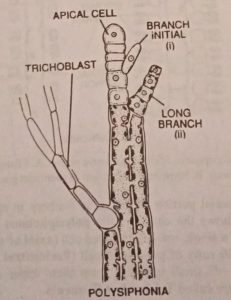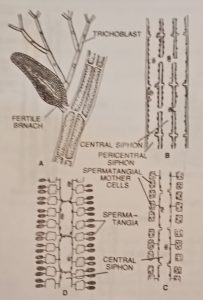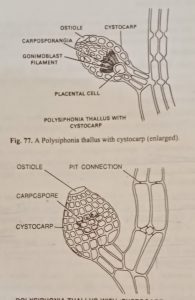BSc 1st Year Botany Rhodophyta Sample Model Practice Question Answer Papers
BSc 1st Year Botany Rhodophyta Sample Model Practice Question Answer Papers: BSc is a three-year program in most universities. Some of the universities also offer BSc Honours. After getting enrolled for BSc, there are certain things you require the most to get better grades/marks in BSc. Out of those, there are BSc Study Material, BSc Sample Model Practice Mock Question Answer Papers along with BSc Previous Year Papers. At gurujistudy.com you can easily get all these study materials and notes for free. Here in this post, we are happy to provide you with BSc 1st Year Botany Rhodophyta Sample Model Practice Question Answer Papers.

BSc 1st Year Botany Rhodophyta Sample Model Practice Question Answer Papers
Q.1. Describe the cycle of Polysiphonia.
Ans.1. This execlusively marine alga is cosmopolitan in distribution and represented by more than 150 species (Bold and Wynne, 1978). It occurs commonly in littoral and sublittoral zones, tidal marshes and estuaries. P. platycarpa, P. variegata. P. urceolata, and P. ferulacea are some of the common Indian species reported from the Western Coast. Recently, Zahid et al. (1981) described 10 species of Polysiphonia from coasts of Karachi (Pakistan).
P. fastigiata is semiparasitic on Ascophyllum nodosum, where P. ferulacea and P. urceolata occur epiphytically on the thalli of Laminaria. P. elongata is a common lithophyte occurring attached on rocks and stones of the seahorse, whereas P. variegata occurs in brakish waters.
Structure
Polysiphonia has a beautiful filamentous plant body with delicate feathery branches. It is attached to the substratum in water by hold fasts. They are generally small in size from a few to several inches in height. They are brownish red to dark purple red in colour. The plant body consists of two types of filaments.
(1) Basal prostrate filaments, which creep over the substance and are anchord to it by means of thick walled unicellular rhizoids.
(2) Upright or vertical filaments. These arise form creeping filaments.

In some species e.g., P. elongata, P. violaceae the creeping or prostrate system is absent.
The upright or aerial portion of thallus is feathery in appearance. The axis and branches shows the characteristic polysiphonous habit e.g., the plant body consist of a single row of elongated cell (axial or central siphon) Surrounded by 4 to 20 rows of pericentral cell (Pericentral siphon). Some pericentral cells cut off small branches form their upper cell. These are monosiphonous and are called Trichoblast filaments.

The cells of the main axis and the branches are composed of a two layered cell wall. The inner layer is made up of cellulose and the outer one of pectic substances. In the centre of each transverse wall is a pit connection The cells are uninucleate and contain a number of band shaped or discoid plastids lying in the peripheral layer of cytoplasm.
Reproduction
The plant Polysiphonia may reproduce either by sexual or asexual means of reproduction. The asexual reproduction takes place by tetraspore after sexual reproduction.
Sexual reproduction
The sexual reproduction is of oogamous type. Most of the species, are dioecious. The sex organs are borne on fertile trichoblasts near the apex of thallus.
The antheridia ‘or spermatangium (male reproductive organs) are produced on the fertile trichoblast of the male thallus, in clusters. Each antheridium is a small rounded colourless, uninucleate body and produces a single-non motile spermatium. (BSc 1st Year Botany Rhodophyta Sample Model Practice Question Answer Papers)

Spermatongia are borne in clusters on small branches (male trichoblast) near the apex of male plants. Each male trichoblast divides dichotomously and usually both the branches thus formed become fertile. Except the lower most cell of this branch all other cut off pericentral cells. These cells com spermatangial mother cell at their free ends. Each spermatangium has a large nucleus and colourless cytoplasm. Its protoplast produces a single male cell or spermatium.
The procarp (female reproductive organs) remain present on carpogonial branch produced upon the greatly reduced fertile branch of female thallus. It consists of a upper long enlogated trichogyne and the lower flattened carpogonium. It includes several cells in addition to carpogonium and the trichogyne.
The procarp or carpogonium develops from a fertile pericentral cell. which divides into an upper carpogonial branch initial and basal supporting cell. The carpogonial branch’s initial cell further divides into three or four cells forming carpogonial branch. (BSc 1st Year Botany Rhodophyta Sample Model Practice Question Answer Papers)
The upper cell carpogonial branch elongates and forms trichogyne while the basal region broadens into carpogonium in which the female Nucleus lies. Simultaneously with the development of carpogonia filament, the supporting cell cuts off two sterile filament initials, the basal sterile initial and lateral sterile initial.
Asexual reproduction
The carpospore which is diploid on liberation from cystocarp elongates and divides by several transverse and longitudinal division to form a diploid tetrasporophytic plant which is morphologically similar to haploid Polysiphonia plant. These tetrasporic plant form tetrasporangia from pericentral cells.
The fertile pericentral cells divides longitudinally. The outer half develops cover cell and the inner half divides transversely giving rise to lower small stalk cell and an upper tetrasporangium.
The tetrasporangium elongates and increases in size. Four haploid tetraspores are formed within each tetrasporangium as a result of one reduction and one mitotic division. (BSc 1st Year Botany Rhodophyta Sample Model Practice Question Answer Papers)
On liberation, the tetraspores germinate and give rise to normal gametophytic plants. (BSc 1st Year Botany Rhodophyta Sample Model Practice Question Answer Papers)
Fertilization
The non-motile spermatium is carried by water currents and is lodged against the mucilaginous wall of the trichogyne. At the point of contact, the spermatial and trichogynal walls dissolve, the spermatial nucleus travels down to the base of the carpogonium and there fuses with the egg nucleus and results in the formation of zygote (2x). (BSc 1st Year Botany Rhodophyta Sample Model Practice Question Answer Papers)
Development of Sporocarp (Cystocarp)
Soon after fertilization the basal and lateral sterile cells divide into several sterile cells. The supporting cell cut off an auxillary cell towards the upper side. A tubular connection established between the carpogoniurn and auxiliary cell.

Through this tubular connection, the zygote nucleus (after mitotic division into two) passes into the auxiliary cell. The supporting cell gradually fuses with the auxiliary cell. The axial cell of the fertile tier of the female trichoblast, and the sterile nutritive cell form a large irregularly shaped placental cell that bears a single diploid nucleus. The placental cell gives rise to several gonimoblast filaments. Each cell of the gonimoblast filaments contains a single diploid nucleus.
The terminal cell of these filaments gets transferred into carposporangia. The naked protoplast of each carpasporangium is the carpospore having a diploid nucleus.
Simultaneously with the development of the carpospore the adjacent cells of the filament begin to grow and form a two-layered envelope, the pericarp with a conspicuous astiole at the distal end. The entire structure is known as cystocarp or sporocarp or carposporophyte or fruiting body.
The carpospore is liberated by an opening in the carposporangium and come out through the ostiole. These on germination give rise to sexual diploid plants or tetrasporophyte. (BSc 1st Year Botany Rhodophyta Sample Model Practice Question Answer Papers)
Development of carpospores into tetrasporophyte and tetraspored and formation of new Polysiphonia haploid plant.
BSc 1st Year Botany Rhodophyta Sample Model Practice Question Answer Papers
BSc 1st Year Botany Rhodophyta Sample Model Practice Question Answer Papers
BSc 1st Year Sample Model Practice Mock Test Question Answer Papers